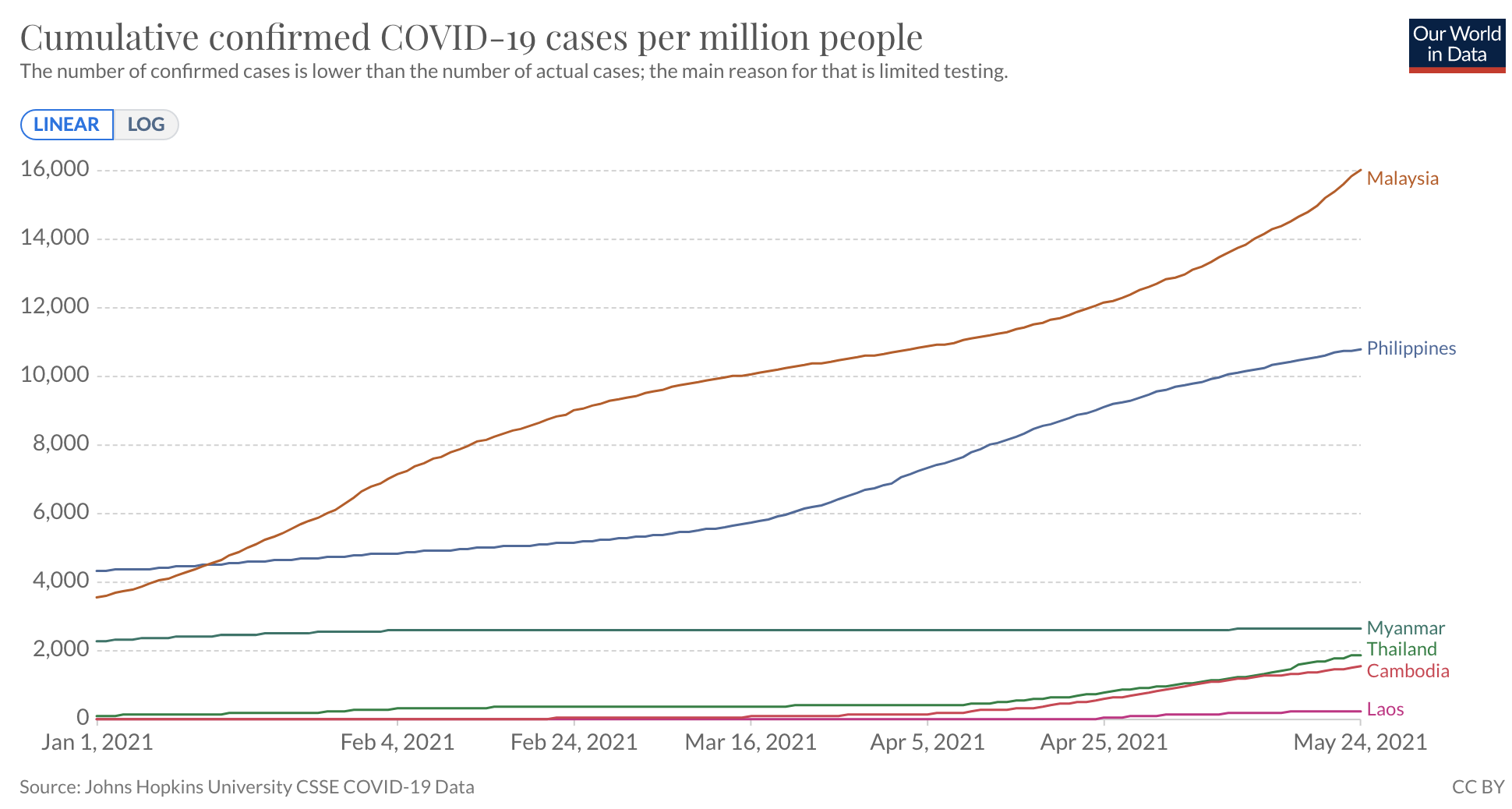According to THE STRAITS TIMES, largely spared the brunt of the Covid-19 pandemic for most of 2020, South-east Asia is now in the grip of a new wave of infections that is putting unprecedented pressure on health systems of countries in the region and threatening to bring their economies to the ground.
In Thailand, hospital beds are quickly filling up after infections, first seeded in some exclusive entertainment outlets in Bangkok, resulted in the country's highest-ever number of daily cases in early April. The number spiked again after Songkran, the Thai new year.
Since then, the caseload has crept upwards and has more than quadrupled to nearly 135,000 as authorities struggled to contain outbreaks in overcrowded prisons, markets and camps housing construction workers.
THE STRAITS TIMES says, in neighboring Malaysia, daily cases have hovered at over 6,000 for the past week. On May 25, 7,289 cases were reported, a day after a record 61 deaths were registered along with 711 admissions to intensive care units.
While Malaysia's caseload of over 525,000 infections is nowhere near India's 26 million, its per capita daily confirmed cases on a seven-day rolling average at 194 for every million people have already surpassed India, which stands at 178 per million.
THE STRAITS TIMES mentions, in the Philippines, a variants-fuelled surge that began in December has seen hospitals overwhelmed. Cases leapt to more than 15,000 a day, three times last year's peak number. As hospitals ran out of beds, harrowing tales of Covid-19 patients dying at home and in hospital parking lots and walkways dogged the headlines, forcing the government to fall back to what has proven to be its most potent weapon: a hard lockdown.
Sweeping quarantine restrictions in Metro Manila and four nearby provinces - home to a quarter of the nation's population and where cases were highest - from March 29 to April 10 brought infections down by half. Still, there are concerns that another surge is not far off. In one region just south of Metro Manila - with a population of some 3 million - 55 per cent of tests are coming back positive.
"In the Philippines, we are seeing the cases coming down, but not to the extent that we like because all four variants of concern are circulating there."
The four variants include the B117 which originated in Britain, the B1351 variant first detected in South Africa, and the P1 strain first found in Brazil. The Philippines has also detected another highly transmissible variant, dubbed the "double mutant" B1617 that was first identified in India and which has also been detected in Malaysia, Cambodia, Indonesia, Thailand, Singapore and Vietnam.
THE STRAITS TIMES adds, while the explosion of cases in Thailand and Malaysia are worrying, experts are more concerned about other countries where the healthcare system is not as well equipped and hence more vulnerable to rising cases, such as Cambodia, Laos and Myanmar.
Cambodia and Laos, which were largely spared last year - thanks to swift and stringent measures and protection from neighboring countries which have done relatively well in keeping the virus at bay - are seeing an exponential rise in cases.
Both countries have blamed the outbreak on foreigners and returning migrant workers. In Cambodia, the B117 variant which spawned the new wave in the country in February was suspected to have spread to Thailand.
The hospitals are so overwhelmed in Cambodia that Prime Minister Hun Sen on April 7 ordered health officials to prepare to treat Covid-19 patients at home.
"We can't accept all patients in case that cases increase further," he told reporters. Three days later, he announced that the number of infections had reached a level beyond hospital capacity. The country's caseload has jumped 50 times since February to 25,205 as of May 23. As of Feb 1, it had only 466 cases, according to Johns Hopkins University's Covid-19 tracker.
Bogged down by its own political crisis after the Feb 1 coup, Myanmar has given up on updating its daily Covid-19 figures as rigorously as before.
"If we talk about the absolute number of cases, Thailand and Malaysia come on top. But, at the same time, we have to remember these two countries have a high number of people being tested and these two countries have good and robust health systems," said Dr Abhishek. "However, if we look at Cambodia, Laos and Myanmar, they don't have an equally developed health system. So, an increasing number of cases in these countries will be a matter of concern."







